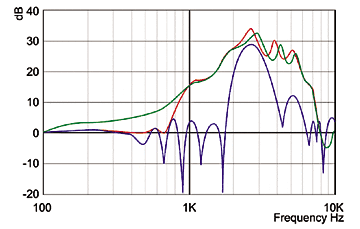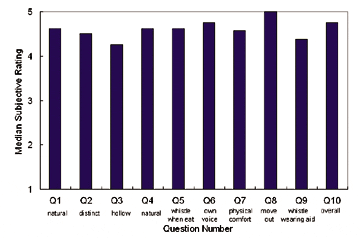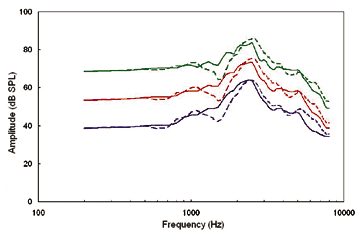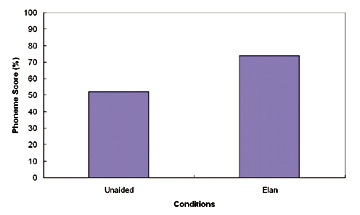Tech Topic | February 2005 Hearing Review
Open fitting (or open ear fitting) is not a new concept. Through the judicious use of tube fitting or large vents, one may achieve several advantages using this type of fitting. These include the reduction or elimination of the occlusion effect (ie, the hollowness of the wearer’s voice when talking, chewing, etc),1,2 improved sound quality (both own voice and others’ voices),3,4 and improved localization ability.5
Recently, this type of fitting has gained commercial popularity as a solution for high frequency hearing loss. But “open fitting” is not simply “tube fitting” or the use of a larger vent. The openness of the ear canal (versus the occluded condition) modifies the acoustic condition of the ear and may lower the performance of the hearing aid and result in undesirable artifacts unless compensations are made to minimize them. This paper examines the considerations in an open (or tube) fitting, and reports on how the Diva élan hearing aid is designed to overcome many of the limitations of an open fitting.
Challenges of an Open Fitting
Reduction of hearing aid low-frequency output. As the vent diameter (or leakage between the ear canal wall and the hearing aid) increases, the effective low frequency cut-off of the hearing aid increases. Dillon6 showed that a tube fitting reduced the hearing aid output at 500 Hz by as much as 30-35 dB. This means that an open fitting should be restricted only to those with normal or near-normal hearing in the low frequencies unless bass compensation is provided. Otherwise, the hearing aid may not provide sufficient amplification for the wearer and may result in a poor perceived sound quality.
Increased contribution of direct sounds. Typically, the SPL at the eardrum of a hearing aid wearer originates primarily from the hearing aid. External sounds in the low frequencies may reach the eardrum with very little attenuation through leakages between the earmold and the ear canal surface (or through the vent).
The degree of attenuation depends on the vent diameter and on how tight the earmold fits in the ear. In a tight earmold, the attenuation might be as high as 20-30 dB in the high-frequency range. Dillon6 showed that the insertion loss of an earmold/shell decreased as the vent diameter increased. In a tube-fitting, the real-ear occluded response (REOR) of the hearing aid with its acoustic coupling is practically equal to the real-ear unaided response (REUR). With an occluding earmold/shell, the REOR and REUR differ significantly.
Hearing aid fitting typically incorporates acoustic corrections to the coupler response so that the desired insertion gain is achieved by the hearing aid when it is worn. The correction has been called CORFIG (COupler Response for Flat Insertion Gain).7 In deriving the CORFIG for a specific style of hearing aid, an occluding earmold (or hearing aid shell) was assumed. For example, CORFIG includes a compensation for the lost ear canal resonance (ie, REUR), the real-ear-to-coupler difference (RECD) and the microphone location effect (MLF) to achieve the desired insertion gain.
In an open fitting, however, one may design an ear-set that not only minimally affects the REUR, but also enhances the frequency range between 2500-3000 Hz. In this way, the gain correction that is used to overcome the loss of ear canal resonance can be minimized. The acoustic difference between an open fit and a closed fit must be considered and accounted for in an automatic fitting. Otherwise, the amplified sound may interact with the direct sound to result in an output where phase cancellation occurs at several frequencies.
Perceptual consequences of direct low frequency sounds. The low frequency sounds that enter directly through the vent/leakage interact with the amplified sounds to create audible artifacts that may lower subjective sound quality and reduce the potential effectiveness of the signal processing algorithms.
“Dips” and “peaks” in real-ear response. Most of our discussion assumes that sounds entering through the leak (ie, direct sounds) are negligible compared to the amplified sounds. On the other hand, if the amplified sounds and the direct sounds are equal or similar in magnitude but opposite in phase (possible from the processing of the hearing aids), they will cancel each other and result in “dips” or energy minima. One can observe these dips during real-ear verification. This could lower the perceived sound quality and compromise the processing of the hearing aid.
Reduction of the effectiveness of signal processing. The direct entry of sounds through the vent into the residual ear canal could also influence the effectiveness of the signal processing algorithms. In a closed or a minimally vented earmold, the influence of the direct sounds is minimal because the magnitude of the processed sounds is substantially larger than that of the direct sounds. On the other hand, an open-fitting reduces the low-frequency output of the hearing aid by as much as 30 dB below 1000 Hz but allows the low-frequency sounds from the environment to enter into the ear canal directly without any attenuation. Together these two mechanisms mean that the low-frequency sounds at the eardrum are primarily dominated by the direct sounds. Any effect of signal processing by the hearing aid may be reduced. Fortune8 showed that the effective compression ratio decreased as the vent diameter increased. Ricketts9 showed that the real-ear directivity index of a directional microphone decreased in the low frequencies as the vent diameter increased. Some mechanisms to preserve the signal processing advantages must be included so that the wearer may enjoy the comfort of an open fitting and still benefit from the signal-to-noise ratio (SNR) advantage of a directional microphone and/or noise reduction algorithm.
Reduction of available gain before feedback. An increase in vent diameter (or leakage) increases the likelihood of feedback. This places a limit on the amount of usable or available gain from the hearing aid. Kuk10 measured the maximum usable gain from a tube-fitting and reported an averaged high-frequency insertion gain of 19 dB. For successful implementation of open fitting, an active feedback cancellation algorithm should be available to increase the amount of available high-frequency gain before feedback. Otherwise, a significant compromise in speech audibility may result.
Reduced audibility especially at low input levels. The reduction of low-frequency output and the limitation in high-frequency gain associated with an open-fitting would suggest that audibility (in both the low and high frequencies) for soft sounds may be compromised, especially if the hearing loss in the low frequency is significant. Figure 1 shows the averaged phoneme recognition score at a 30 dB HL input level from a group of high-frequency hearing loss listeners (n =10) as the vent diameter on the earmold was changed from 0 mm to a tube-fitting. Phoneme recognition score on the word test was relatively stable (around 76%) up to a 3 mm vent diameter. However, performance with the tube-fitting was only half of the closed earmold (76% vs 38%). One must ensure audibility while achieving comfort with an open fitting.
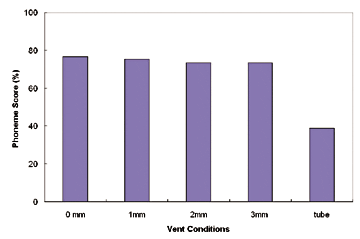
Figure 1. Averaged phoneme recognition scores on the CASPA word test15 presented at 30 dB HL as a function of vent diameters (and tube-fitting).
Consequently, an appropriate hearing aid solution for an open fitting must incorporate hardware and software considerations so that the challenges listed above are at least partially met.
New Solution for High Frequency Hearing Loss
The Senso Diva élan hearing aid is specifically designed for the sole purpose of fitting adults with a high-frequency hearing loss (especially precipitously sloping) using an open-fitting concept. This hearing aid was designed on the hardware of the Diva hearing aid in order to capitalize on its proven effectiveness in various listening situations.11-13 Additional software considerations were included to meet the challenges of an open fitting. The hardware and software considerations that are pertinent to an open fitting include:
• Hardware considerations
1. Use of an Infinite Impulse Response (IIR) filter technique to achieve the 15-channel enhanced dynamic range compression (EDRC) system. The use of IIR filters allows steeper filters with a minimal group delay (about 2 ms). This filter design allows precise frequency shaping while avoiding any “echoic” perception that may originate from excessive group delay.
2. Fully adaptive directional microphone (Locator™) that has a high in-situ directivity index especially in the low frequencies.12 This design is different from many directional microphone designs where the maximum directivity index is in the high frequencies. The rationale is to allow for the potential decrease in real-world directivity index when the Diva is worn with a significant vent diameter. A high directivity index in the low frequencies, even with the reduction in low frequency DI in an open-fitting, will retain more directivity than one with a lower directivity index. This design ensures some signal-to-noise ratio (SNR) benefit in noisy backgrounds with an open fit.
3. Active feedback cancellation that includes static and dynamic components. The static component limits the instantaneous gain of each of the 15 channels to just below the point of feedback. The dynamic component constantly evaluates the acoustic conditions and generates an anti-feedback signal to subtract it from the input when a potential feedback occurs. This allows the wearer to use 10-12 dB more gain before feedback.14
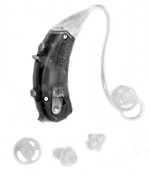
4. Non-occlusion of the ear canal with an instant-fit élan ear-set. To enhance wearer comfort and facilitate the fitting process, a custom ear-set was designed to be used with the hearing aid (Figure 2). The ear-set includes a specialized earhook connected to a thin tubing of 3 possible lengths (62 mm, 66 mm, and 70 mm) which can be selected for the wearer. The tubing is connected to an ear insert that is available in two diameters and two insertion depths. The ear-set does not occlude the ear canal, thus preserving the localization cues for the wearers. An “anchor,” or adjustable ring, is fastened to the tubing for a more secure placement of the ear-set. The fitting process would involve selecting the ear-set with the appropriate dimensions. An instant fit that is both comfortable and discreet is possible.
• Software considerations. The use of the ear-set in an open-fitting changes the acoustic conditions to which the output of the hearing aid is coupled to the outer ear. Although the general objective of the élan fitting remains the same as the Diva—bringing audibility for soft sounds and comfort to loud sounds with excellent sound quality—the algorithm to achieve this objective has to be modified to reflect and compensate for the acoustic changes in an open fitting. Therefore, a new feature, called SoundHarmony™, has been developed as a collection of software algorithms to ensure that the hearing instrument, when used with the élan ear-set, yields excellent sound quality. SoundHarmony included the following considerations, and the combined result can be seen in Figure 3.
Figure 3. In-situ gain responses showing the effect of the SoundHarmony™ algorithms. The green curve is the response of the Senso Diva hearing aid in a closed earmold. The dark blue curve is the response of the Senso Diva with the ear-set only (ie, without the algorithms), and the red curve is the response with the Diva élan hearing aid (ie, ear-set plus the algorithms). Note the similarities in smoothness between the red (Diva élan) and green curves (Diva in closed earmold). This is in contrast to the dips in the dark blue curve (open fitting without algorithms).
1. Compensation of low frequency loss from open fitting. The new hearing aid compensates for this loss in the fitting algorithm to preserve normal loudness.
2. Correction for insertion characteristics in an open fitting. The hearing instrument incorporates a new set of gain corrections based on an open fitting so that the desired insertion gain is achieved without adjustment by the clinician. This allows an easy fit with instant success.
3. Minimization of phase cancellation. A series of software amplification rules are implemented so that any phase cancellation between the direct sounds and the amplified sounds is minimized. This results in a fuller, smoother real-ear output that ensures audibility and exceptional sound quality of the hearing aid.
4. Compensation for related tubing resonance. Special corrections are made to the fitting formula to account for the acoustic properties of the ear-set so that the desired output is achieved instantly.
Validation Study
In order to demonstrate the overall effectiveness of the élan hearing aids, eight adult subjects (average age = 64 yrs, SD = 11.5 yrs) with primarily a high frequency sensorineural hearing loss above 1000 Hz were recruited into the clinical study. All were fit with binaural Diva élan hearing aids with the ear-set. Four were experienced hearing aid wearers.
The hearing aids were fit according to the recommended protocol. The appropriate ear-set for the hearing instruments was first selected to ensure a comfortable fit. Then, the unaided in-situ thresholds at 500 Hz, 1000 Hz, 2000 Hz, and 4000 Hz were determined. This was followed by a feedback test in which the maximum available gain before feedback was measured with the feedback canceling mechanism activated. The default settings were used and no adjustment was made on the hearing aids. Subjects wore the hearing aids for at least 1 week before any testing began. Subjects returned for a retest a week after the initial testing. The averaged performance between test and retest sessions was reported as there was no statistically significant difference between the two sessions.
Subjects completed the following tests during their visits. For speech recognition in quiet, all subjects completed the CASPA15 word lists presented at 30 dB HL via a loudspeaker placed at 0° azimuth 1 meter away. The HINT16 was used to evaluate the participants’ ability to recognize speech in the presence of noise. The speech material was presented directly in front, and the HINT speech noise was presented from three loudspeakers placed at 90°, 180°, and 270°. The noise was presented continuously at 75 dB SPL and the speech level was adaptively varied until 50% correct identification was reached. During the speech-in-noise testing, the hearing aids were set to 4 combinations of noise reduction (on and off) and microphone modes (omnidirectional and adaptive directional). The sequence of NR x microphone setting was counterbalanced across subjects. The subjects’ performance in the unaided condition was also determined during the last visit.
Subjects completed a 10-item custom questionnaire17 that measured the real-world satisfaction of hearing aids on issues of comfort and fit.
In regards to the occlusion effect, participants were asked to judge the hollowness of their voice (with the hearing aids in-situ) when they repeated the phrase “Baby Jeannie is teenie tiny” at a normal vocal effort. A 1-10 point hollowness rating scale was used, with 1 being the most hollow/problematic and 10 the least hollow/most natural/least problematic. In addition, they also chose 1 of 5 potential categories to best describe their reaction to the hollowness of their own voice. These categories were:
1) It’s very noticeable and very distracting, I cannot adapt to it;
2) It’s moderately noticeable and distracting, but I can adapt to it;
3) It’s noticeable but not distracting;
4) It’s hardly noticeable unless I focus my attention to it;
5) It’s not there (very natural).
To measure the objective occlusion effect, subjects were instructed to sustain their phonation of /i/ for 5 s. The real-ear output of the vocal production was recorded unaided and aided with the hearing aids turned on (ie, aided response) using the Fonix 6500 real-ear system. The recorded output was frequency-averaged for 3 s with a custom Matlab program in order to improve the response stability.
Finally, to examine the real-ear acoustic difference between the Diva élan (with SoundHarmony and ear-set) and the Diva in a tube-fitting, the real-ear aided response (REAR) of the two hearing aids was measured at the same settings with a speech-shaped noise (ANSI 92) at input levels of 50, 65, and 80 dB SPL. Only the output from the right ear was measured. The same probe microphone insertion depth was used for each subject in all real-ear measurements.
Results
Effect of the open ear-set. The main motivation for an open fitting is the elimination or minimization of the occlusion effect. One aspect of measuring the success on this objective can be examined in Figure 4 which displays the averaged real-ear unaided response during vocalization of /i/ (REURvoc) and the averaged real-ear aided response during vocalization of /i/ (REARvoc). An increase in the real-ear output between the REAR and the REUR in the low frequencies can be attributed to the occlusion effect.18 Figure 4 shows similar output below 700 Hz between the two curves, suggesting that no objective occlusion effect was observed during vocalization with the use of the hearing aid.
Figure 4. REURvoc and REARvoc during vocalization of /i/ with the Diva élan hearing aids. Note the similarity in output between the two curves below 700 Hz, suggesting that objective occlusion effect was not present.
A high, positive subjective reaction to the ear-set can be seen on the 10-item questionnaire in Figure 5, specifically on item #3 regarding perceived hollowness of own voice and item #6 regarding acceptability of own voice. A median rating of 4.5 (out of 5) was seen on both these items. In addition, the ear-set fit comfortably and securely as reflected in the responses to items #7 regarding physical comfort and #8 regarding tendency to move out of ear when chewing, speaking, etc. Contrary to what one might assume with an open fitting, real-life use of the ear-set did not result in whistling of the hearing aid while the subjects ate (#5) or moved (#9). In addition, a median rating of 9.5 (out of 10) was observed when subjects rated the hollowness of their voice and a median “hollowness reaction” category of 4.5 (out of 5) was chosen. This suggests that the majority of subjects did not notice any hollowness of their own voice when talking.
Figure 5. Median subjective ratings of the élan hearing aid on the 10-item questionnaire.17
Effect of the special algorithms. While the ear-set may reduce the occlusion effect during vocalization, the ear-set alone is not sufficient to ensure a good sound quality with open-fitting. The merit of the SoundHarmony feature can be demonstrated by the smoothness of the aided response of the hearing aid, the sound quality ratings, and good speech recognition ability for soft sounds by the trial subjects.
Figure 6 compares the real-ear aided responses of the Diva élan hearing aid to the Diva hearing aid in an open-fitting mode at the same gain setting. The ANSI speech noise was presented at 50 dB, 65 dB, and 80 dB SPL. An immediate observation is that the Diva élan curves are smoother than the Diva curves which are more irregular, along with a peak around 1000 Hz and a dip around 1500 Hz. Furthermore, the bandwidth of the response with the Diva élan is broader (than Diva open-fitting) at the lower input levels. However, the response bandwidth decreases as input level increases. The smoother response and the broader response may explain the observations on the good sound quality ratings on the 10-item questionnaire reported in Figure 5. Items #1 (regarding naturalness of speech sounds), #2 (distinction of speech sounds), #4 (naturalness of own voice) and #10 (overall rating of performance) showed that the median ratings on these items are between 4.5 and 5 on the 5-point scale, confirming that the SoundHarmony feature results in excellent sound quality judgment.
Figure 6. Real-ear aided responses (REAR) to a speech-shaped noise at 50 dB (blue), 65 dB (red), and 80 dB (green) SPL input levels to the Diva elan (solid curves) and Diva open-fitting (dashed curves). Note the smoothness of the Diva élan curves.
Figure 7 compares the phoneme recognition scores between the Diva élan fitting and the unaided speech scores on the CASPA word list. The average score for the hearing aid was 74% and that of the unaided condition was 52%. The gain provided by the élan amplification scheme improved the unaided score by almost 50% (from 52% to 74%). It is of interest to note that this performance was similar to a closed earmold fitting with the Diva hearing aid under the same test condition (as seen in Figure 1).
Figure 7. Phoneme recognition scores on the CASPA presented at 30 dB HL between the unaided and Diva élan conditions.
Effect of open fitting on directionality and noise reduction effectiveness. A key concern with any open fitting is the potential loss of the directional benefit and the reduction in the efficacy of the noise reduction algorithm. Figure 8 compares the absolute SNR for 50% correct identification on the HINT when the adaptive directional microphone and noise reduction algorithm were separately activated and deactivated. For the purpose of comparison, the SNR for the subjects to achieve 50% correct in the unaided condition was also included. (Note: Normal-hearing subjects required a SNR of 1.6 dB to reach 50% correct on the HINT under the same test condition).
Figure 8. Absolute signal-to-noise ratio (SNR) for 50% correct performance on the HINT in various conditions: unaided; omni mic & noise reduction off; omni mic & noise reduction on; adaptive directional mic & noise reduction off; and adaptive directional mic & noise reduction on.
Figure 8 shows that the average subject required a SNR of 4.8 dB to achieve 50% correct on the HINT in the unaided mode. A similar SNR was required when the Diva élan was in the omnidirectional microphone mode without any noise reduction (4.8 dB). The noise reduction (NR) algorithm improved the SNR by about 0.8 dB in the omnidirectional mode (from 4.8 dB to 4.0 dB) and 0.8 dB in the adaptive directional mode (from 3.0 dB to 2.2 dB). The adaptive directional microphone improved the SNR by 1.8 dB in the NR Off mode (from 4.8 to 3.0 dB) and 1.8 dB in the NR On mode (from 4.0 to 2.2 dB). In its typical mode of operation (ie, adaptive directional microphone and NR on), the hearing instrument improved the required SNR over the omnidirectional mic without NR condition by 2.6 dB (from 4.8 dB to 2.2 dB). Repeated measures, 3-factor (test session x microphone mode x noise reduction state) ANOVA showed that the effect of the microphone and of the noise reduction was statistically significant (F(1,7) = 16.06 and 7.75 for microphone and noise reduction respectively, p < 0.05).
Discussion
The current study showed that it is possible to achieve no or minimal occlusion effect in hearing aid fittings while providing excellent sound quality and improved speech understanding in quiet and in noise with a well-designed adaptive directional microphone that emphasizes the low-frequency directivity index and a signal processing algorithm that considers the acoustic impact of the open ear.
The current study results were obtained with an ear-set that offers minimal occlusion of the ear canal. The advantage is clearly seen in the elimination of the occlusion effect. The disadvantage, however, is seen in the magnitude of the SNR improvement offered by the adaptive directional microphone. In this study, an average improvement of 1.8 dB SNR was observed between the adaptive directional microphone and the omnidirectional microphone. The same adaptive directional microphone, when evaluated in other studies where the vent diameter was typically less than 2.0-2.5 mm, showed a directional benefit that varied from 4 dB12 to 4-6 dB.13 In another study19 where the Diva adaptive directional microphone was fit on individuals with a more severe hearing loss (and consequently no venting was used), an even higher directional benefit of 6-8 dB was reported.
The current finding is in line with our belief that vent diameter decreases the directivity index of a directional hearing aid. Thus, the choice for specific vent diameters must be made judiciously. Otherwise, an improvement in occlusion, through the use of open fitting, could compromise the amount of directional benefit provided by the hearing aid.
What is noteworthy from the results of this study is that a significant amount of directional benefit and noise reduction benefit was still available even with an open-fitting. A logical question would be the ideal candidates for this type of fitting so that its advantage (occlusion reduction) is maximized while the impact of its disadvantages (such as feedback and loss of directional and noise reduction benefit) may be minimized.
Subjects in this study received a 2.6 dB improvement in SNR (over the omnidirectional and no NR condition) in addition to excellent sound quality ratings and a high phoneme recognition score. This magnitude of SNR improvement is not small when one recalls that this group of subjects had a mild SNR deficit to begin with (unaided SNR was 4.8 dB). Consequently, the actual SNR required by these subjects with the use of the élan hearing aid (2.2 dB) was close to that of people with normal hearing when tested under the identical condition.
However, one must refrain from concluding that people wearing the Diva élan perform similarly in noise as people with normal hearing. Rather, one should recognize that open fitting was most beneficial (or least compromising) for people with a mild hearing loss or a precipitous hearing loss with normal low-frequency hearing (ie, subjects used in this study) where their SNR loss may be mild. People with a more severe hearing loss (or even a moderate hearing loss) in the low and mid frequencies, or those with a mild high-frequency hearing loss but severe SNR loss, may not be good candidates for an open fitting. In these cases, more traditional fitting using appropriate vent diameters will be necessary in order to obtain full benefit of the hearing aids.
References
1. Berland O. No-mold fitting of hearing aids. Scand Audiol. 1975;5[Suppl]:173-193.
2. Courtois J, Johansen P, Larsen B, Christensen P, Beilin J. Open molds. In: Jensen JH, ed. Hearing and fittings: Theoretical and Practical Views. 13th Danavox Symposium. Stougaard Jensen:Copenhagen; 1988.
3. Cox R, Alexander G. Acoustic versus electronic modifications of hearing aid low-frequency output. Ear Hear. 1983;4(4):190-196.
4. Kuk F. Perceptual consequences of venting in hearing aids. Brit J Audiol. 1991;25:163-169.
5. Noble W, Sinclair S, Byrne D. Improvement in aided sound localization with open earmolds: observations in people with high-frequency hearing loss. J Am Acad Audiol. 1998;9(1):25-34.
6. Dillon H. Earmolds and high frequency response modification. Hear Instrum. 1985;36(12):8-12.
7. Killion M, Monser E. CORFIG: coupler response for flat insertion gain. In: Studebaker GC, Hochberg I, eds. Acoustical Factors Affecting Hearing Aid Performance. Baltimore: University Park Press; 1980.
8. Fortune T. Real ear compression ratios: the effects of venting and adaptive release time. Am J Audiol. 1997;6(2):52-63.
9. Ricketts T. Directivity quantification in hearing aids: fitting and measurement effects. Ear Hear. 2000;21(1):45-58.
10. Kuk F. Maximum usable insertion gain with various earmold configurations. J Am Acad Audiol. 1994;5:44-51.
11. Ludvigsen C, Kuk F. New Solutions for Age-Old Hearing Aid Problems. The Hearing Review. 2001;8(11):32-36, 55.
12. Kuk F, Keenan D, Nelson J. Preserving directional benefits for new users wearing smaller hearing aids. Hear Jour. 2002;55(10):46-52.
13. Valente M, Mispagel K Performance of an automatic adaptive dual-microphone ITC digital hearing aid. The Hearing Review. 2004;11(2):42-46, 71.
14. Kuk F, Ludvigsen C, Kaulberg T. Understanding feedback and digital feedback cancellation strategies. Hearing Review. 2002;9(2):36-41, 48.
15. Mackersie C, Boothroyd A, Minniear D. Evaluation of the Computer-assisted Speech Perception Assessment Test (CASPA). J Am Acad Audiol. 2001;12(8):390-396.
16. Nilsson M, Soli S, Sullivan J. Development of the Hearing in Noise Test for the measurement of speech reception thresholds in quiet and in noise. J Acoust Soc Am. 1994;95(2):1085-1099.
17. Bongiovanni R, Auriemmo J, Kuk F. Is a longer canal length always better when fitting CIC hearing instruments? The Hearing Review. 2001;8(9):44-48, 77.
18. Revit L. Two techniques for dealing with the occlusion effect. Hear Instrum. 1992;43(12):16-18.
19. Kuk F, Keenan D, Ludvigsen C. Is real-world directional benefit predictable? The Hearing Review. 2004;11(11)18-25.
About the authors: Francis Kuk, PhD, and Denise Keenan, MA, work in the Widex Office of Research in Clinical Amplification (ORCA) in Lisle, Ill. Marianne Sonne, MA, and Carl Ludvigsen, MA, work at Widex A/S in Vaerloese, Denmark.
Citation for this article: Kuk F, Keenan D, Sonne M, Ludvigsen C. Efficacy of an open-fit hearing aid. Hearing Review. 2005;12(2)[Feb]:26-32.


